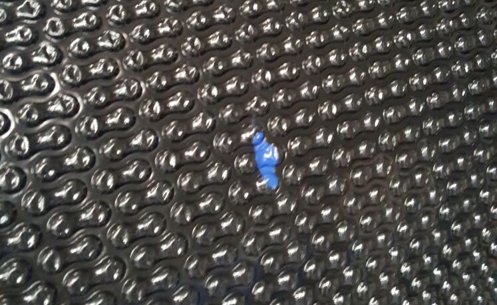Who Killed The Cover?
Who killed the cover?
11 causes of bubble cover disaster and how to avoid them
To get the most from your GeoBubble™ swimming pool cover, it’s important that it’s well taken care of. A properly looked after cover can last more than 8 years*, but these common pitfalls can drastically reduce that. Keep reading to discover the most common pool cover problems and how to avoid them.
*lifespan is dependent on cover type. Please refer to your manufacturer’s warranty
1.Bleached cover? It’s probably the Chemicals
When you shock dose your pool, the free chlorine levels are elevated from the normal 2 to 4ppm (parts per million) to as high as 10ppm, and can reach 30ppm when removing algae blooms. The increase in sanitiser is essential in burning off foreign matter in the pool and allowing the by-products such as chloramines to gas out of the pool – as a result active sanitizer levels in the pool quickly return to balance.
However, if you leave your pool cover on during a shock dosing, the cover is exposed to the intense levels of the oxidant, trapping the by-products under the cover – this reduces the efficiency of the chemical treatment. The problem of chemical degradation can be further exacerbated by high temperatures such as on a hot tub.
It is therefore important to remove the cover when shock dosing the pool or when the pool is out of balance, and only return it to the pool once chlorine levels have stabilised to 2-4 parts per million (ppm).
Noticeable effects of shock-dosing with a cover on:
- Bleaching of the underside of the cover.
- Bleaching of the hemming/edge.
- Material has turned brittle – in particular on the bubble layer.
- High residue amounts on the cover.
- Oxidation of eyelets.
2. Cover your cover – Overheating on the Reel System
GeoBubble™ Covers are designed to heat the water and insulate your pool to keep the heat in. When left uncovered and exposed on the reel system, this solar heating ability results in a rapid elevation in temperature at the centre of the roll. Tests have found temperatures in excess of 80˚C at the roll’s core.
This can cause bands of poor lay flat to form on the cover when laid across the pool – you’ll see that these bands increase in frequency as they get closer to the reel system, or if the cover has been fan folded, you’ll see these bands on the folding edges.
GeoBubble™ covers are made from Polyethylene (PE), which is a thermoplastic. This means that it becomes malleable as the cover reaches its Vicat softening point (90°C). As your cover then cools, the material sets to the shape of the reel, resulting in the poor lay flat on your pool. In extreme cases covers can even oxidise or weld layers of the cover material together.
This issue can be easily avoided by simply covering your covering with a reflective sheeting. This will reflect the sun away from your cover, reducing the solar heating. Ask your supplier about our Reflective sheet.
3. Help! My cover is shrinking!
Don’t panic! Shrinkage of the cover can happen and is often exaggerated by bubble swell (see point 4).
Shrinkage happens as the cover heats up, and polymer in the material releases stress as it gains molecular mobility.
We help to limit this shrinkage in our GeoBubble™ covers by removing as much of the stress as possible during our production processes, but while we endeavour to prevent as much tension as possible it is not possible to completely eliminate all tensions from the production process.
It has, therefore, become a common part of industry’s best practice to over size the cover by 2% in its length to allow for a small amount of shrinkage as the cover settles on the pool.

4. Why have my bubbles swollen!?
Now this one is rare, but it does happen. Often this gets mistaken for shrinkage, but bubble swell is a separate problem. Although it is not entirely clear what causes this, key factors seem to be atmospheric pressure, pool temperature and chemical levels.
Signs that you have swollen bubbles may include:
- The bubble resists compression.
- The cover has appearance of lumps in random patches of the cover
5. The top’s coming off my bubbles!
We use the term ‘Top hatting’ to describe when the flat top surface of the cover starts to peel away from the material around the bubble profile.
Top hatting usually occurs as the cover starts to degrade either chemically or from UV as it reaches the end of its lifespan.
However, it can also be caused by overheating. As we mentioned earlier – a cover could reach in excess of 80°C sitting on a reel, which could cause permanent damage to the cover – including top hatting.
We most often see this problem in materials with a dark/opaque top surface, but with a well monitored chemical regime and appropriate storage, this can often be prevented.
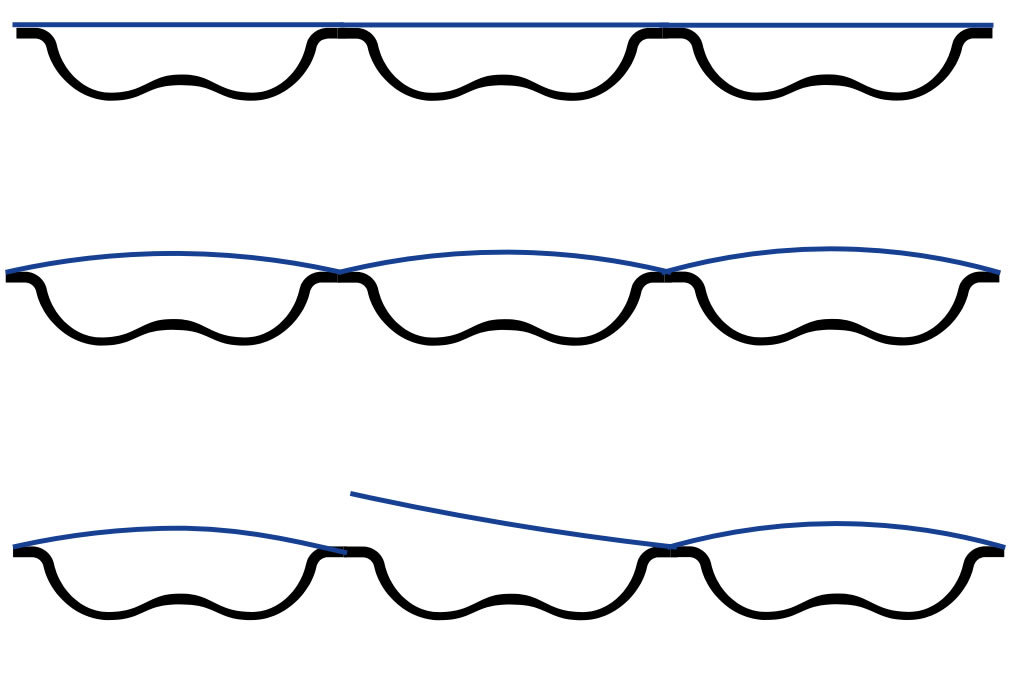
6. Bubble Collapse
The bubbles on the underside of your bubble cover have deflated – but why? This is more commonly seen in round bubble covers (our patented GeoBubble™ covers have been found to be more resilient to damage of this kind).
Bubble collapse is very rare but can be caused by the build-up of Nitrogen trichloride (NCI3) which is one of the chloramines produced by the reaction of Hypochlorous acid (HOCl) and Ammonia (NH3), derivatives in the warm water.
Solution:
The pool chemistry can be returned to balance by removing the cover and performing a break point chlorination or draining a portion of the loaded water with fresh.
Sadly though, once bubble collapse has occurred, the bubbles will never return to their previous state, but actions taken to correct the issue will prevent this happening to a replacement cover.
7. My cover’s peeling apart – Delamination
Bubble pool cover materials are made of two layers – a flat top sheet and bottom sheet that is vacuum formed into the bubble profile. These two layers are laminated together just after the mould forms the bubble, forming a permanent bond between the layers.
Very occasionally these two layers can peel apart. Something we call delamination. This is incredibly rare but when it does happen is most often due to the cover overheating when being stored off the pool. As we’ve already talked about, when folded or left uncovered on a reel system, the material quickly heats up and causes the air within the bubbles to expand and in extremely rare cases this can force the layers of material apart.
We at GeoBubble™ have developed our own testing practices to ensure the material is securely bonded in order to avoid problems of this kind. Our materials are tested regularly to ensure a permanent and strong lamination.
This is another problem that can be avoided by using a reflective storage sheet. Should delamination occur without indications of improper storage please contact us immediately.

8. Bird pecks
A much more common problem than you might think! Small groups of punctured or torn holes are often caused by birds.
At our testing site we have a particular Herring Gull family who seem very fond of pecking through our test covers. We’re yet to ascertain their motives, but suspect they’re trying to get at the water.
Note: No legal action has been taken against the Herring Gull family at this point!
We have found that a few CDs hanging from a string will cause reflections that discourage the birds from lingering around the pools.
9. There’s water in my bubbles! Condensation and water incursion
From time to time it may appear that small droplets of water have appeared within the bubbles. This is simply the result of condensation. This really is no cause for concern and is a natural result of a temperature difference between the pool and the air and will have no detrimental effect to the covers performance or longevity.
The polymer that the cover is manufactured from will resist water ingress, so any bubble that fills with water completely, will be the result of a rupture to the bubble. Usually the most noticeable sign that a bubble or bubbles across the cover have ruptured is the spread of algae or build-up of debris within the bubble.
If you have one or more of these signs, the first step to identify the cause is to look for where the rupture is in the bubble.
Bubble rupturing is often caused when a reel system is set to far back from the pool or the cover is removed by hand –
the underside of the bubble can be easily scuffed, causing a rupture through abrasion on rough surfaces and edges.
This is simple to identify – flip the cover over in the affected area and press down on the bubble. As the pressure builds you will see bubbles or water ejecting from the affected area.
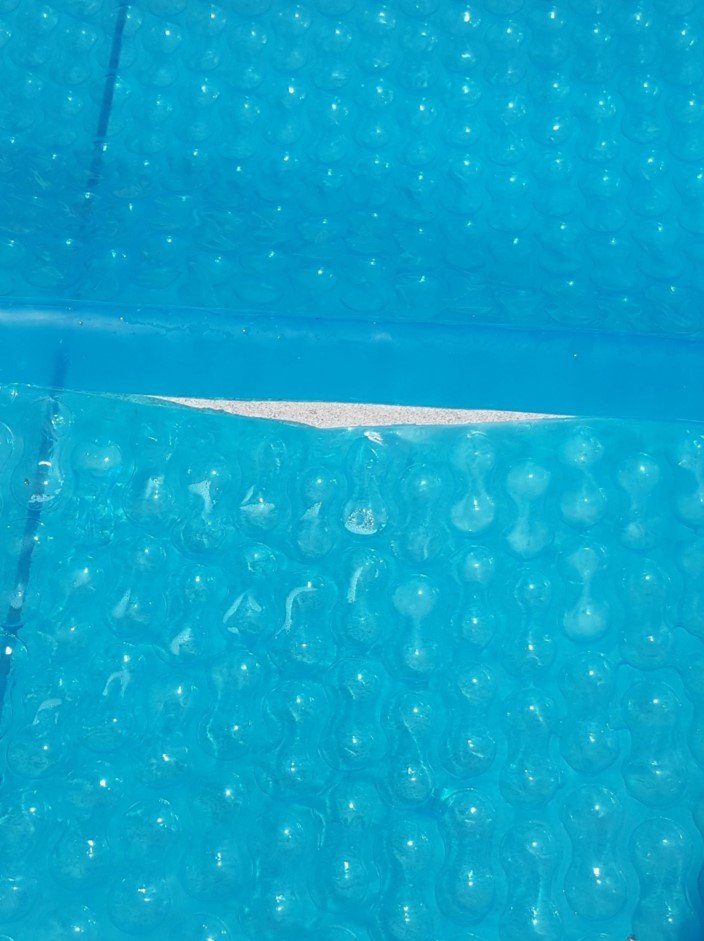
10. Splits at the weld edge
A score line appears as a fine spilt next to the weld edge – where two sections of material have been welded together to form a cover – and is caused by damage to the material during welding.
While there are tapes that can bond the materials together. This is not a permanent solution. If this occurs in the early days of the cover’s working life it is better to seek a replacement from the company who supplied the cover to you than attempt a repair.
11. Lensing
Lensing can appear in both the top and bubble layer of your cover and will result in a tear shaped deformation in the bubble.
It’s caused by a rupture in one of the material films during production, and can be triggered by a process known as “Gelling” from the polymers or from an unmelted piece of polymer or debris working its way through the production line.
- On the top layer it will appear as an opening that exposes the inside of the bubble.
- On the bubble layer it will pull the top layer down to form the bubble profile.
At GeoBubble™, we closely monitor our production constantly to be able to react should we see a imperfection on the line. But sometimes, some do get through.
If you receive a roll with lensing that renders the material unusable, please do not hesitate to contact us.
Reporting an issue
Should you have an issue with a cover and require assistance with what has caused the issue or a fault requires the cover to be replaced, please contact the company who supplied the cover with as much of the below information stated as possible.
- Description: material name, bubble design and thickness.
- Dimensions: Size of the cover affected.
- QC tracking: We track our materials and the raw material that they are created from because of this we require
- Year/Month/Day/the date stamp on the weld edge of the material or the QC number (quality control sheet number) from the roll/rolls the material was
fabricated from. - Pool information: To understand what has happened to the cover please provide as much information on the pool’s chemical environment as possible.
- Images: The majority of the time we can determine what has happened to the material from an image. To do this please provide an image of the entire
cover as well as a close up to demonstrate the particular issue.
To help you send this info, we provide a Solar cover problem checklist on our downloads page. Our warranties are between ourselves and the cover fabricator who purchased the material. As such we will not comment on any cover issues sent to us by end users.
Should you own a cover and have an issue that requires action or advice, they will contact us should they feel it requires are attention and we shall act accordingly after reviewing the details














